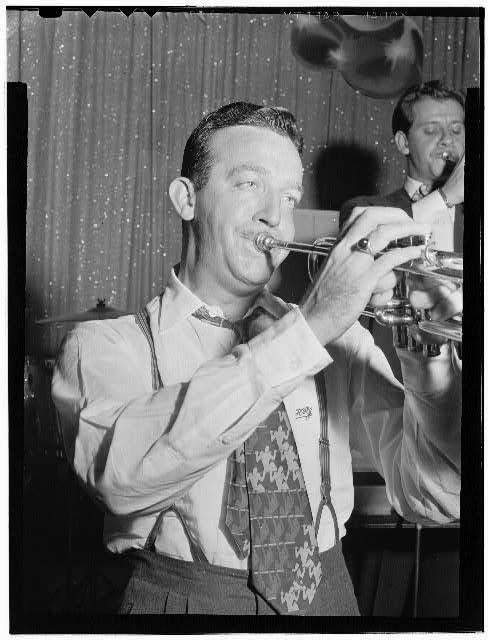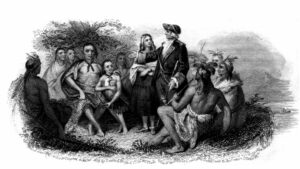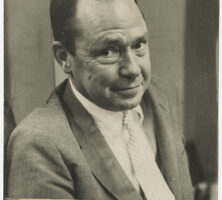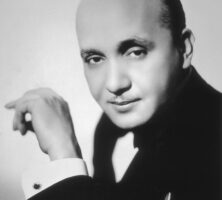Georgia, though far from the jazz centers of New Orleans, Louisiana; Chicago, Illinois; and New York City, produced some of the most important swing musicians of the big band era. Many of these gained their fame after migrating to northern urban centers, but the musicians who stayed in the South contributed to the thriving swing scene in Savannah during the 1930s and 1940s.
Fletcher Henderson
Fletcher Henderson from Cuthbert, in Randolph County, is credited with forming the first swing band in 1924, which included drummer Joseph “Kaiser” Marshall from Savannah. Similar to Paul Whiteman’s band, the group did not swing much at first, but the addition of horn player Louis Armstrong to the group started a new musical genre. Don Redman altered his arrangements for Henderson’s band to reflect the more rhythmically adventurous soloing of Armstrong, and the style of music they produced influenced many big bands to follow. Until Henderson’s last group disbanded in 1950, many of jazz’s greatest players spent time with Henderson, including Sahib Shihab from Savannah, Coleman Hawkins, Roy Eldridge, Red Allen, Cootie Williams, Fats Waller, Benny Carter, and Ben Webster. Fletcher’s brother Horace Henderson also spent time as a bandleader and contributed arrangements to Fletcher’s bands as well as many others.

Image from Wikimedia
By the end of the 1920s, prominent bands led by Duke Ellington and Bennie Moten had formed, but the swing era is considered to have begun at a 1935 concert in Los Angeles, California, by Benny Goodman. Thereafter, swing bands started all over the country, which increased the popularity of Fletcher Henderson. Goodman’s band performed many Henderson songs and arrangements, and Goodman credited the source for his material. When Henderson’s bands suffered in popularity or disbanded, he found work either playing or composing and arranging for Goodman.
Savannah Jazz
One of the cities that produced a successful swing movement was Savannah. In the 1920s and 1930s such local bands as Raymond Snype and His Golden Syncopators, Ted Pollen’s Syncopated Six, Al Cutter’s Snappy Six, Leland Longley’s Georgia Rhythm Kings, the Georgia State College Swing Band, and Larry Noble’s band played at numerous venues around the city. The most prominent clubs, such as Powell Hall, the Golden Dream Club, the Harlem Club, and Tybrisa, hosted concerts by local groups as well as bands led by Goodman, Ellington, Armstrong, and many others.
By the 1940s additional bands and clubs augmented the already busy swing scene. Walter Langston and the Savannahians, Fish Ray’s Victory Hoppers, and James Drayton’s band performed at Gus’ Tavern, the Rainbow Room, the Lincoln Inn, and the Melody Theater. Throughout the first half of the decade, most of the major swing bands returned to Savannah to perform. After World War II (1941-45), however, the national appeal of swing music waned, and the swing scene in Savannah also declined, as different genres of music captured the public’s attention and economic forces made traveling with a large group difficult.
Other Swing Musicians from Georgia
After Fletcher Henderson the most important swing bandleader from Georgia was trumpeter Harry James, a native of Albany. James spent two years with Benny Goodman before forming his own band. A steady string of hits and the employment of such popular vocalists as Connie Haines from Savannah and Frank Sinatra made James’s big band the most popular swing group of the late 1940s.

Courtesy of Library of Congress, Music Division
Several famous swing trombonists hailed from Georgia. James “Trummy” Young from Savannah, J. C. Higginbotham from Social Circle, and Lou McGarity from Athens all played for many popular big bands. An early jazz trumpeter, Cladys “Jabbo” Smith from Pembroke, rivaled the popularity of Louis Armstrong. Pianist Mary Lou Williams from Atlanta played for most of the twentieth century, which included time leading her own swing combos, accompanying Andy Kirk, and arranging for Ellington, Goodman, Armstrong, and others. Eddie Heywood Jr. from Atlanta, a pianist and son of the blues pianist Eddie Heywood Sr. from Atlanta, led his own groups and played with Benny Carter and Don Redman as well. Fred Guy from Burkesville was a banjo and guitar player for Duke Ellington from 1925 until 1949. The lyricist and vocalist Johnny Mercer from Savannah wrote numerous popular songs of the era—now classics—and sang with Goodman. Joe Williams from Cordele became famous by singing for many years with Count Basie.

Courtesy of Hargrett Rare Book and Manuscript Library, University of Georgia Libraries.
When the swing era ended after World War II, many big bands disbanded or struggled into the 1950s. Many of Georgia’s jazz musicians, however, most notably Mary Lou Williams and J. C. Higginbotham, continued to play and evolve along with modern jazz. Today, neoswing bands have revived interest in big band music, but the music hasn’t captured the attention of the nation as it did so many decades ago.









